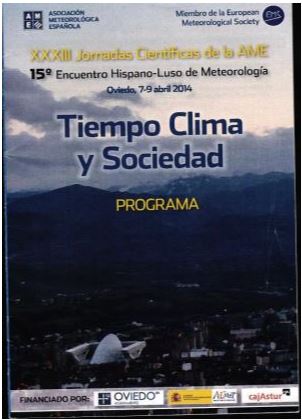EXTREMOS PARA EL SIGLO XXI EN ESPAÑA PENINSULAR: PERIODOS DE RETORNO DE TEMPERATURA Y PRECIPITACIÓN
Resumen
El Grupo Intergubernamental de Expertos sobre el Cambio Climático, IPCC, analiza, desde su creación, la problemática del cambio climático. El último informe, 2013, asegura, con un 90% de seguridad, que se ha incrementado la frecuencia de los fenómenos extremos (IPCC, AR5, SMP, 2013). Estos fenómenos tienen un gran impacto en la vida y en la seguridad de las personas y, en general, en las actividades socio-económicas.En el presente trabajo, se analiza el cambio de los periodos de retorno para ciertos umbrales de temperatura y precipitación para mediados y finales del siglo XXI en España peninsular. Para ello, se utiliza una colección de datos diarios de temperatura y precipitación a nivel de observatorio obtenidos por métodos de regionalización estadística por la Agencia Estatal de Meteorología (AEMET).
Citas
IPCC (2000). Emissions Scenarios. Nakicenovic N. & Swart R. Cambridge Univ. Press, Cambridge, U.K.
IPCC (2013). Resumen para responsables políticos. En Cambio Climático 2013: Bases físicas. Contribución del Grupo de trabajo I al Quinto Informe de Evaluación del Grupo Intergubernamental de Expertos sobre el Cambio Climático. Stocker, T. F., Qin, D., Plattner, G.-K., Tignor, M. M. B., Allen, S. K., …, Midgley, P. M. (Eds). IPCC, 2012: Managing the Risks of Extreme Events and Disasters to Advance Climate Change Adaptation. A Special Report of Working Groups I
and II of the Intergovernmental Panel on Climate Change [Field, C.B., V. Barros, T.F. Stocker, D. Qin, D.J. Dokken, K.L. Ebi, M.D. Mastrandrea, K.J. Mach, G.-K. Plattner, S.K. Allen, M. Tignor, and P.M. Midgley (eds.)]. Cambridge University Press, Cambridge, UK, and New York, NY, USA, 582 pp.
Kharin, V. V, Zwiers, F. W., Zhang, X., & Wehner, M. (2013). Changes in temperature and precipitation extremes in the CMIP5 ensemble. Climatic Change, 119, 345–357. DOI:10.1007/s10584-013-0705-8
Kharin, V. V., and F. W. Zwiers (2005). Estimating extremes in transient climate change simulations. J. Climate, 18, 1156–1173.
Petisco de Lara, S. E., Ramos-Calzado, P. & MartínHerreros, J. M. (2012). Extremos de temperaturas y precipitación para el siglo XXI en España. Cambio climático. Extremos e impactos. Rodriguez Puebla, C., Ceballos Barbancho, A., González Reviriego, N. Morán Tejeda, E. & Hernández Encinas, A. (Eds). Publicaciones de la AEC, serie A, nº 8.
Ramos, P., Petisco, E., Martín, J. M., Rodríguez, E. (2012) Downscaled climate change projections over Spain: application to water resources, International Journal of Water Resources Development. DOI:10.1080/07900627.2012.721700
Ramos-Calzado, P. & Rodríguez-Camino, E. (2011). Temperature and precipitation extremes over Spain for the 21st century. EMS Annual Meeting Abstracts. Vol.8. EMS2011. 11th EMS/10th ECAM.
ENSEMBLES project (2009). Ensembles: Climate change and its impacts at seasonal, decadal and centennial timescales . Summary of research and results from the ENSEMBLES project.Van der Linden, P. , Mitchell , J. F. B., Gilbert , P.
Zwiers F. W., Zhang X. & Feng Y. (2006). Anthropogenic Influence on Long Return Period Daily Temperature Extremes at Regional Scales. Journal of Climate, Vol, 24. p,881-892. DOI: 10.1175/2010JCLI3908.1

